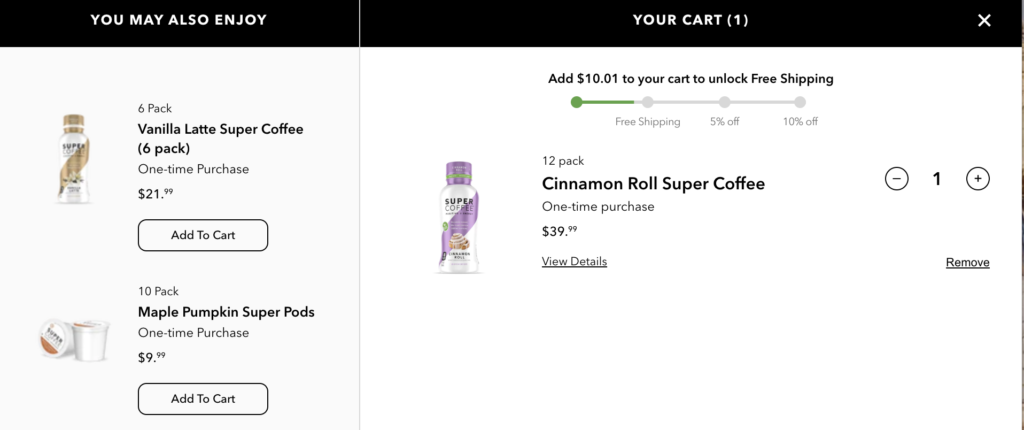Anyone that works in the ecommerce industry knows that there are a million terms and acronyms used on a daily basis. Learning those terms—and their significance when it comes to running an ecommerce business—is crucial. But what separates gross merchandise value or gross merchandise volume (GMV) from the pack? And why is it such an important ecommerce term to learn?
The answer is simple: GMV is a key metric that ecommerce brands can use to measure the growth of their store.
So, learning more about GMV and how it’s calculated will be vital to creating a successful business model and better understanding your revenue. With full access to your financial data, you can make informed business decisions and work to increase total sales.
Key takeaways
- Gross merchandise value is an important metric for ecommerce brands to analyze.
- When GMV goes up, it can be one positive indicator of the health of a business.
- GMV is just one of the many financial metrics that merchants should use to track their success.
- There are several strategies for increasing GMV.
What is gross merchandise value?
As it’s defined in our ecommerce glossary, gross merchandise value is “a metric that represents the total monetary value of all goods and services sold by a merchant in a given period.” It is typically measured on a quarterly or annual basis, and is a metric that many in the ecommerce industry rely on for growth measurement.
GMV can also be used to determine the overall health of a merchant, since it looks at both the volume and value of the products being sold. When your gross merchandise value is up, it can reflect positively on the health of your business.
GMV vs. net sales
Since gross merchandise value does not account for expenses like advertising or marketing costs, it cannot be viewed as the sole indicator of success for your ecommerce store. Net sales and net income must also be accounted for in order to gain a full picture of your business’s success. Other financial metrics that should be considered include:
- Customer acquisition cost (CAC)
- Customer lifetime value (LTV)
- Net merchandise value
- Churn rate
- Average order value (AOV)
- Conversion rate
- Profit margin per product
How is GMV calculated?
To calculate gross merchandise value for your ecommerce store, you can multiply the sales price charged to customers by the amount of merchandise sold. Depending on your business, GMV can also represent your gross revenue. In order to achieve revenue and GMV growth, you’ll have to sell more products, or increase prices.
Advantages & disadvantages of GMV
As with any measure of your company’s growth, there are pros and cons to consider when talking about gross merchandise value. It’s crucial to look at additional metrics along with GMV when you want to determine the success of your ecommerce store.
Advantages of gross merchandise value
Company performance insights
The biggest advantage of measuring GMV is that, when considered in the context of other key performance indicators (KPIs), it can give valuable insight into how well your ecommerce brand is performing. Analyzing the number of items sold and the price at which they are selling can offer crucial data for running your business.
To get the best insight, merchants should measure their gross merchandise value once a quarter. If it is only measured annually, there is less opportunity to make changes in how you market or sell your products. Instead, if GMV is down one quarter, your store can identify the cause, then adjust and try to make up for that loss.
Comparative measure over time
Measuring gross merchandise value frequently—or at least once a quarter—will help your company analyze growth and success over time. By regularly measuring GMV, you can compare the current quarter sales to those of the last year. Plus, you can look at growth year over year, along with other metrics. GMV acts as a way to analyze sale numbers and see how your business is performing, which will be helpful as your ecommerce store grows and expands.
Disadvantages of gross merchandise value
Doesn’t reflect profitability
Merchants shouldn’t count on gross merchandise value to show their profitability. Companies that want to learn if they are profitable or not have to take their net income (revenue minus expenses) and divide it by revenue (or net sales). To get a profit margin percentage, multiply this outcome by 100.
Because gross merchandise value only takes into account the number of products sold and their cost to consumers, there’s no way to show how much profit your company is making from those sales. Taking into account the other financials associated with profit, like production and shipping costs, will give your company a better picture of profitability.
Doesn’t account for every factor
As mentioned, sellers have to consider other factors in order to get a better idea of their overall company health. GMV won’t be up to that task, since there are so many other factors to consider. Looking at your business’s revenue along with GMV will help you avoid seeing a false financial picture.
Gross merchandise value is calculated before the deduction of expenses and fees that go along with the product, meaning it doesn’t account for every financial factor that your ecommerce store should be analyzing. Businesses must also take into account:
- Discounts
- Advertising costs
- Delivery costs
- Returns
- And more
Doesn’t show the whole picture
So, if there are a number of other financial factors that have to be considered when looking at your company’s overall growth and success, then GMV won’t show you the whole picture. As a financial metric, it can be limiting—which is why it’s crucial to recognize gross merchandise volume for what it is, and rely on other metrics in addition to GMV.
Some factors that are important to consider to view the whole picture of your business health include:
- How much revenue is from repeat customers
- The number of customers visiting your online store
- How much you’re spending on ads and marketing
- The cost of manufacturing your products
Doesn’t express the true value of goods
Without taking into account the costs associated with producing your goods, GMV can’t express the true value of what you’re selling. Instead, it gives you a snapshot of growth based on unrefined data. To see the true value of your goods, you have to factor in these production costs.
How to increase gross merchandise volume
There are a number of strategies to increase your GMV in ecommerce settings. When your company makes moves to increase the amount customers are spending when they shop with your store, those efforts can also positively impact gross merchandise volume. Continue reading to learn about three strategies for increasing your GMV.
Bundling
Giving consumers the option to bundle their products can help you boost your company’s GMV by increasing the number of goods sold. Typically, bundles come with a discount, which will make your customers happy and help you get rid of more inventory. Bundling can also increase your AOV.
Cross-selling
Another effective way to increase your gross merchandise value is by cross-selling. By showing customers additional products that would add value to their purchase, you are automatically creating an opportunity to increase AOV and with it, GMV.

Free shipping
One of the easiest ways ecommerce brands can up their GMV is by setting a threshold for free shipping. For example, you could offer free shipping to those customers who spend $50 or more. By offering this shipping discount, you give consumers an incentive to spend more money at your online store. When buyers spend more money, GMV goes up.

Utilizing GMV as a helpful tool for ecommerce analytics
Despite some of its disadvantages, gross merchandise value can be a powerful metric for ecommerce brands looking to track their growth and see how successful their operations are. When measured frequently enough—such as each quarter—and looked at over time, GMV is a helpful metric to see if your ecommerce store is operating well, and what changes need to be made to increase GMV and total revenue.



